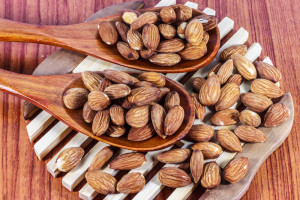Written by Jessica Patella, ND. Daily snacking on 36 almonds (250 calories) for 4 weeks suppressed hunger levels and did not affect body weight in individuals at risk of developing type two diabetes.
 Snacking in the U.S. is on the rise. An estimated 97% of adults consume at least one snack per day compared to 71% in 1977 (1-3). The number of snacks per day has also increased since 1977 from 1 snack per day to 2.2 snacks per day (1-3) and the snack size has increased from 165 kcal per day to 264 kcal per ay (1-2). The growth in snacking results in more calorie intake per day and increased body weight can be associated with the increase in snacking (4). However, recent research has found snacking on almonds can suppress hunger and does not affect body weight (1).
Snacking in the U.S. is on the rise. An estimated 97% of adults consume at least one snack per day compared to 71% in 1977 (1-3). The number of snacks per day has also increased since 1977 from 1 snack per day to 2.2 snacks per day (1-3) and the snack size has increased from 165 kcal per day to 264 kcal per ay (1-2). The growth in snacking results in more calorie intake per day and increased body weight can be associated with the increase in snacking (4). However, recent research has found snacking on almonds can suppress hunger and does not affect body weight (1).
Almonds are known for varied health benefits, including healthy fats, magnesium, protein, vitamin E and fiber (1, 5). For this reason, they were researched as a possible healthy snack food for Americans (1).
The study included 150 participants who were at increased risk of developing type 2 diabetes (based on 2-hour glucose tolerance test <11.1 mmol/l and being either overweight, obese or have a family history of diabetes). The participants were randomly divided into five groups (n=30 per group):
- Control group (avoided nuts and seeds during the study period)
- Breakfast group (consumed 43 grams of almonds* with breakfast daily)
- Lunch group (consumed 43 grams of almonds with lunch daily)
- Morning snack group (consumed 43 grams of almonds between breakfast & lunch)
- Afternoon snack group (consumed 43 grams of almonds between lunch & dinner)
*Forty-three grams of almonds are equivalent to about 36 whole almonds.
After 4 weeks, despite the additional 250 calories per day from almonds, the daily intake of total calories in all almond groups was not significantly higher than baseline or the control group. This indicated that participants subconsciously self-regulated their daily caloric intake (1).
Eating almonds with meals or alone as a snack resulted in lower hunger levels before the following meal. Hunger levels were more suppressed and remained below baseline when consumed as afternoon snacks (P<0.001). Hunger levels were recorded on a visual scale every waking hour for 1 day (1).
Glucose levels 60 minutes after breakfast and lunch were lower when 43 grams of almonds were eaten with the meals, although levels did not reach statistical significance (1). This could be due to the fiber content in almonds (1). There was no significant change in body weight, body mass index or blood pressure throughout the study.
In conclusion, eating 43 grams of almonds per day suppressed hunger and did not affect body weight (1). These findings suggest almonds may be a healthy snack option. Past studies have shown that consuming almonds improves fasting glucose, insulin and LDL “bad” cholesterol, although these results were not seen in this study (6-8). This could be due to the short duration and lower intake of almonds compared to previous studies.
Source: Tan, Sze Yen, and R. D. Mattes. “Appetitive, dietary and health effects of almonds consumed with meals or as snacks: a randomized, controlled trial.” European journal of clinical nutrition 67.11 (2013): 1205-1214. & 2013 Macmillan Publishers Limited All rights reserved 0954-3007/13
© 2013 Macmillan Publishers Limited
Posted November 19, 2013.
Jessica Patella, ND, is a naturopathic physician specializing in nutrition and homeopathic medicine and offers a holistic approach to health. She earned her ND from Southwest College of Naturopathic Medicine in Tempe, AZ, and is a member of the North Carolina Association of Naturopathic Physicians. Visit her website at www.awarenesswellness.com.
References:
- Tan Y, et al. Appetitive, dietary and health effects of almonds consumed with meals or as snacks: a randomized, controlled trial. 2013 European J of Clin Nutr. dii:10.1038/ejcn.2013.184
- US Department of Agriculture. What we eat in America, 2011.
- Piernas C, Popkin BM. Snacking increased among U.S. adults between 1977 and 2006. J Nutr 2010; 140: 325–332.
- Howarth NC, et al. Eating patterns and dietary composition in relation to BMI in younger and older adults. Int J Obes 2007; 31: 675–684.
- Cassady BA, et al. Mastication of almonds: effects of lipid bioaccessibility, appetite, and hormone response. Am J Clin Nutr 2009; 89: 794–800.
- Lovejoy JC, et al. Effect of diets enriched in almonds on insulin action and serum lipids in adults with normal glucose tolerance or type 2 diabetes. Am J Clin Nutr 2002; 76: 1000–1006.
- Jenkins DJA, et al. Effect of almonds on insulin secretion and insulin resistance in nondiabetic hyperlipidemic subjecys: a randomized controlled crossover trial. Metabolism 2008; 57: 882–887.
- Jenkins DJA, et al. Almonds reduce biomarkers of lipid peroxidation in older hyperlipidemic subjects. J Nutr 2008; 138: 908–913.
